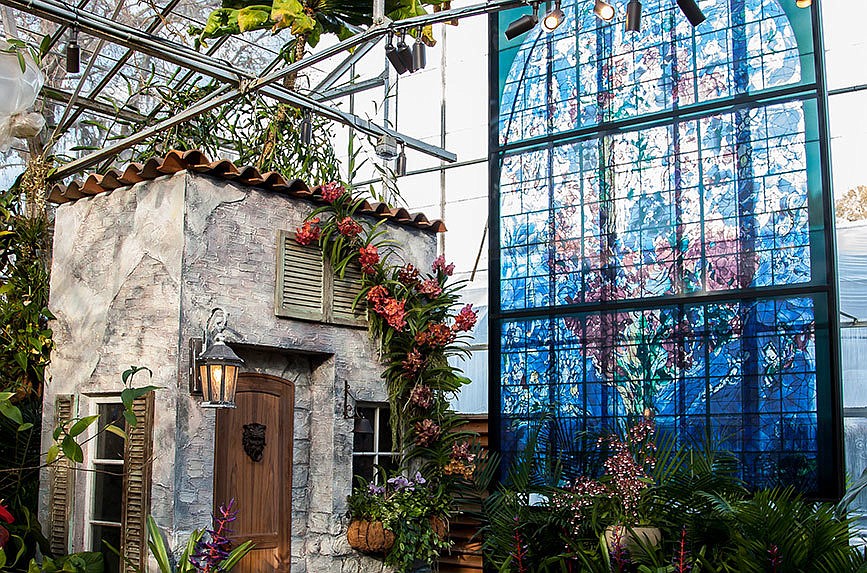- November 23, 2024
-
-
Loading

Loading

Marc Chagall is an artist whose portfolio has been studied at length. Considered one of the greatest painters of the 20th century and a pioneer of modernism, scholars and critics have analyzed his work from just about every angle.
Much of these discussions have centered on his contributions to the art world — especially as a Jewish artist. Born in 1887 in Vitebsk, Belarus, Chagall’s decision to celebrate — rather than deny or cover up — his Lithuanian Jewish heritage in his art was not only a bold and distinguishing one at the time, it also became the lifeblood of his work.
For the rest of his career, until his death in 1985, the dominant imagery in his work — modest wooden houses, fiddlers, roosters, flying cows and landscapes — served as a lifelong love letter to his childhood home.
One aspect of his work, however, has remained relatively unexplored: his connection with flowers and nature.
Presented by the Jewish Federation of Sarasota-Manatee and running through July 31 at Marie Selby Botanical Gardens, Marc Chagall, Flowers and the French Riviera: “The Color of Dreams,” explores this connection, as well as the artist’s life and work, through a collection of painting and never-before displayed works, as well as a gardens-wide homage to his love for the French Riviera. It was here that after several instances of being forced to flee in times of war, he chose to live the later part of his life.
“Even though Marc Chagall was not necessarily called a flower painter, he produced a prodigious output of them,” says Carol Ockman, curator at large. “This is an aspect of his work that has somehow flown under the radar. For him, flowers had a spiritual integrity, which was the measure of all things for him. In many of his paintings, they fill nearly the whole canvas. They were a bridge between heaven and earth.”
Throughout his career, Chagall created art in just about every artistic medium. Accordingly, the interdisciplinary exhibit features a wide range of tributes to the artist throughout Selby’s 15 acres.
Guests begin by exploring a glass-house conservatory. Inside, towering replicas of Chagall’s stained-glass windows catch the light and paint the greenhouse with a warm glow.
Replicas of cottages are draped in orchids, and overhead chandeliers of epiphytes hang near gravity-defying planter pots, which pour streams of flowers from mid air onto the conservatory floor in a nod to Chagall’s love of fantasy.
The grounds as a whole, and both sides of the Great Lawn, are enhanced with flowers meant to evoke the spirit Chagall’s last home and creative muse in the village of Saint Paul de Vence, in the French Riviera.
Finally, in the gallery are archival photos and personal effects, as well as the 1937 masterwork painting, “The Lovers,” on loan from the Israel Museum, Jerusalem, and two privately loaned, never-before displayed paintings from later in his career, “Bouquets de Lilas à Saint Paul de Vence” (1978) and “Couple aux Muguets” (1973).
In “The Lovers,” whose color scheme nods to his then home in Paris, Chagall and his late wife Bella float above an impossibly large bouquet of flowers, greeted by an angel above a small Jewish village. It’s perhaps the best example of his artistic relationship with flowers.
The exhibition, which has been in the works for the last year and a half, is the first installation in Selby Gardens’ Jean and Alfred Goldstein Exhibition Series, which will blend nature and botanical-inspired master artworks.
“The ties between art and nature are part of our founding mission,” says Jennifer Rominiecki, president and CEO of Selby Gardens. “We’ve been hosting art exhibitions since1979, but never at this level. It’s part of our push to make Selby a living museum. Chagall was a perfect fit. He’s been exhibited many times before, but never in the context of his love of flowers and nature — and certainly never in a botanical garden.”
Standing in the glass house conservatory, looking at the constellations of floating epiphytes re-creating Chagall’s paintings in nature, Ockman says she couldn’t imagine a more fitting tribute to the artist.
“It really changes my relationship with an artist I know very well,” she says. “I’m a big fan of interdisciplinary collaboration, and this is a really beautiful one. It’s experiential. It grabs you. It’s filled with color and light, and it captures that element of fantasy and whimsy that people love about Chagall. For all the hardships he endured, there’s a buoyancy in his work that’s appealing. Everyone can relate to a beautiful bouquet of flowers; a couple madly in love; a love for your childhood home.”